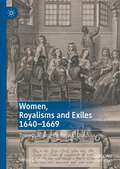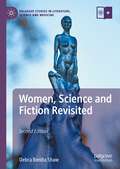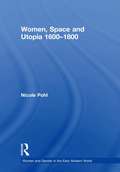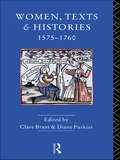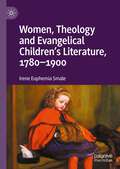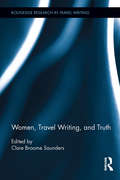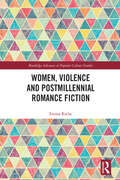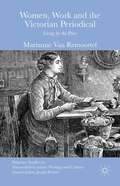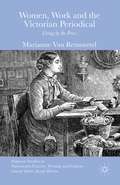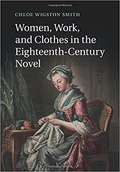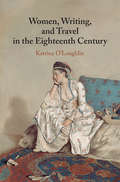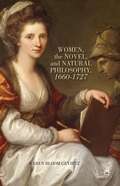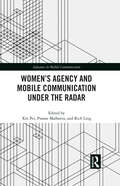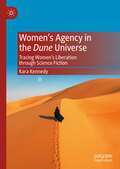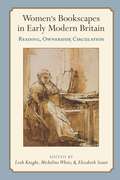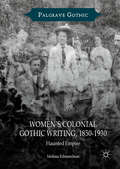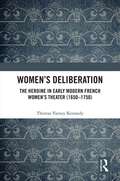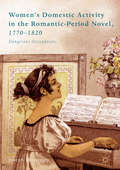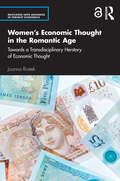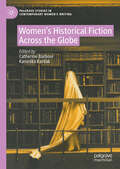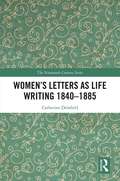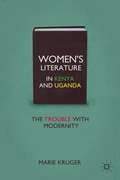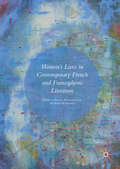- Table View
- List View
Women, Royalisms and Exiles 1640–1669: Towards Writing the Royalist Diaspora
by Sonya CroninThis book examines a range of royalist women’s cultural responses to war, dislocation, diaspora and exile through a rich variety of media across multiple geographies of the archipelago of the British Isles and as far as The Hague and Antwerp on the Continent, thereby uniquely documenting comparative links between women’s cultural production, types of exile and political allegiance. Offering the first full length study to therorize the royalist condition as one of diaspora, it chronologically charts a series of ruptures beginning with initial displacement and dispersal due to civil war in the early 1640s and concludes with examination of the homecoming for royalist exiles after the restoration in 1660. As it retrieves its subjects’ varied experiences of exile, and documents how these politically conscious women produce contrasting yet continuous forms of cultural, personal and political identities, it challenges conventional paradigms which all too neatly categorize royalism and exile during this seminal period in British and European history.
Women, Science and Fiction Revisited (Palgrave Studies in Literature, Science and Medicine)
by Debra Benita ShawWomen, Science and Fiction Revisited is an analysis of selected science fiction novels and short stories written by women over the past hundred years from the point of view of their engagement with how science writes the world. Beginning with Charlotte Perkins Gilman's Herland (1918) and ending with N K Jemisin's The City We Became (2020), Debra Benita Shaw explores the re-imagination of gender and race that characterises women's literary crafting of new worlds. Along the way, she introduces new readings of classics like Ursula Le Guin's The Left Hand of Darkness and Margaret Atwood's The Handmaid's Tale, examining the original novels in the context of their adaptation to new media formats in the twenty-first century. What this reveals is a consistent preoccupation with how scientific ideas can be employed to challenge existing social structures and argue for change.
Women, Space and Utopia 1600–1800 (Women and Gender in the Early Modern World)
by Nicole PohlThe first full length study of women's utopian spatial imagination in the seventeenth and eigtheenth centuries, this book explores the sophisticated correlation between identity and social space. The investigation is mainly driven by conceptual questions and thus seeks to link theoretical debates about space, gender and utopianism to historiographic debates about the (gendered) social production of space. As Pohl's primary aim is to demonstrate how women writers explore the complex (gender) politics of space, specific attention is given to spaces that feature widely in contemporary utopian imagination: Arcadia, the palace, the convent, the harem and the country house. The early modern writers Lady Mary Wroth and Margaret Cavendish seek to recreate Paradise in their versions of Eden and Jerusalem; the one yearns for Arcadia, the other for Solomon's Temple. Margaret Cavendish and Mary Astell redefine the convent as an emancipatory space, dismissing its symbolic meaning as a confining and surveilled architecture. The utopia of the country house in the work of Delarivier Manley, Sarah Scott and Mary Hamilton will reveal how women writers resignify the traditional metonym of the country estate. The study will finish with an investigation of Oriental tales and travel writing by Ellis Cornelia Knight, Lady Mary Montagu, Elizabeth Craven and Lady Hester Stanhope who unveil the seraglio as a location for a Western, specifically masculine discourse on Orientalism, despotism and female sexuality and offers their own utopian judgment.
Women, Texts and Histories 1575-1760
by Clare Brant Diane PurkissFirst published in 1992. Routledge is an imprint of Taylor & Francis, an informa company.
Women, Theology and Evangelical Children’s Literature, 1780-1900
by Irene Euphemia SmaleThis book provides a wealth of fascinating information about many significant and lesser-known nineteenth-century Christian authors, mostly women, who were motivated to write material specifically for children’s spiritual edification because of their personal faith. It explores three prevalent theological and controversial doctrines of the period, namely Soteriology, Biblical Authority and Eschatology, in relation to children’s specifically engendered Christian literature. It traces the ecclesiastical networks and affiliations across the theological spectrum of Evangelical authors, publishers, theologians, clergy and scholars of the period. An unprecedented deluge of Evangelical literature was produced for millions of Sunday School children in the nineteenth century, resulting in one of its most prolific and profitable forms of publishing. It expanded into a vast industry whose magnitude, scope and scale is discussed throughout this book. Rather than dismissing Evangelical children’s literature as simplistic, formulaic, moral didacticism, this book argues that, in attempting to convert the mass reading public, nineteenth-century authors and publishers developed a complex, highly competitive genre of children’s literature to promote their particular theologies, faith and churchmanships, and to ultimately save the nation.
Women, Travel Writing, and Truth (Routledge Research in Travel Writing)
by Clare Broome SaundersThe issue of truth has been one of the most constant, complex, and contentious in the cultural history of travel writing. Whether the travel was undertaken in the name of exploration, pilgrimage, science, inspiration, self-discovery, or a combination of these elements, questions of veracity and authenticity inevitably arise. Women, Travel, and Truth is a collection of twelve essays that explore the manifold ways in which travel and truth interact in women's travel writing. Essays range in date from Lady Mary Wortley Montagu in the eighteenth century to Jamaica Kincaid in the twenty-first, across such regions as India, Italy, Norway, Siberia, Austria, the Orient, the Caribbean, China and Mexico. Topics explored include blurred distinctions of fiction and non-fiction; travel writing and politics; subjectivity; displacement, and exile. Students and academics with interests in literary studies, history, geography, history of art, and modern languages will find this book an important reference.
Women, Violence and Postmillennial Romance Fiction (Routledge Advances in Popular Culture Studies)
by Emma RocheThis book interrogates the significance of the revival and reformulation of the romance genre in the postmillennial period. Emma Roche examines how six popular novels, published between 2005 and 2015 (Twilight, Fifty Shades of Grey, Gone Girl, Sharp Objects and The Girl on the Train), reanimate and modify recognisable tropes from the romance genre to reflect a neoliberal and postfeminist cultural climate. As such, Roche argues, these novels function as crucial spaces for interrogating and challenging those contemporary gender ideologies. Throughout the book, Roche addresses and critiques several key attributes of neoliberal postfeminism, including a pervasive emphasis on individualism and personal responsibility; an insistent requirement for self-monitoring, self-surveillance, and bodywork; the celebration of consumerism and its associated pleasures; the prescription of mandatory optimism and suppressing one’s ‘negative’ emotions; and the endorsement of choice as a primary marker of women’s empowerment. While much critical attention has been devoted to those attributes and their pernicious effects, Roche argues that one crucial repercussion has been largely overlooked in contemporary cultural criticism: how these ideologies function together to effectively sanction gender-based violence. Thus, Roche exploits textual analysis to demonstrate the subtle ways in which neoliberal postfeminism can augment women’s vulnerability to male violence.
Women, Witchcraft, and the Inquisition in Spain and the New World (New Hispanisms)
by Anne J. Cruz Alberto Ortiz Jair Antonio López Claudia Carranza Ana María Burgos Cecilia López-Ridaura Beatriz Moncó Rebollo Yadira Munguía Sonia Pérez-Villanueva Robin Ann Rice Graciela Rodríguez CastañónWomen, Witchcraft, and the Inquisition in Spain and the New World investigates the mystery and unease surrounding the issue of women called before the Inquisition in Spain and its colonial territories in the Americas, including Mexico and Cartagena de Indias. Edited by María Jesús Zamora Calvo, this collection gathers innovative scholarship that considers how the Holy Office of the Inquisition functioned as a closed, secret world defined by patriarchal hierarchy and grounded in misogynistic standards.Ten essays present portraits of women who, under accusations as diverse as witchcraft, bigamy, false beatitude, and heresy, faced the Spanish and New World Inquisitions to account for their lives. Each essay draws on the documentary record of trials, confessions, letters, diaries, and other primary materials. Focusing on individual cases of women brought before the Inquisition, the authors study their subjects’ social status, particularize their motivations, determine the characteristics of their prosecution, and deduce the reasons used to justify violence against them. With their subjection of women to imprisonment, interrogation, and judgment, these cases display at their core a specter of contempt, humiliation, silencing, and denial of feminine selfhood. The contributors include specialists in the early modern period from multiple disciplines, encompassing literature, language, translation, literary theory, history, law, iconography, and anthropology.By considering both the women themselves and the Inquisition as an institution, this collection works to uncover stories, lives, and cultural practices that for centuries have dwelled in obscurity.
Women, Work and the Victorian Periodical: Living by the Press (Palgrave Studies in Nineteenth-Century Writing and Culture)
by Marianne Van RemoortelCovering a wide range of magazine work, including editing, illustration, poetry, needlework instruction and typesetting, this book provides fresh insights into the participation of women in the nineteenth-century magazine industry.
Women, Work and the Victorian Periodical: Living by the Press (Palgrave Studies in Nineteenth-Century Writing and Culture)
by Marianne Van RemoortelCovering a wide range of magazine work, including editing, illustration, poetry, needlework instruction and typesetting, this book provides fresh insights into the participation of women in the nineteenth-century magazine industry.
Women, Work, and Clothes in the Eighteenth-Century Novel
by Chloe Wigston SmithThis groundbreaking study examines the vexed and unstable relations between the eighteenth-century novel and the material world. Rather than exploring dress's transformative potential, it charts the novel's vibrant engagement with ordinary clothes in its bid to establish new ways of articulating identity and market itself as a durable genre. In a world in which print culture and textile manufacturing traded technologies, and paper was made of rags, the novel, by contrast, resisted the rhetorical and aesthetic links between dress and expression, style and sentiment. Chloe Wigston Smith shows how fiction exploited women's work with clothing - through stealing, sex work, service, stitching, and the stage - in order to revise and reshape material culture within its pages. Her book explores a diverse group of authors, including Jane Barker, Jonathan Swift, Daniel Defoe, Eliza Haywood, Samuel Richardson, Henry Fielding, Charlotte Lennox, John Cleland, Frances Burney and Mary Robinson.
Women, Writing, and Travel in the Eighteenth Century
by Katrina O'LoughlinThe eighteenth century witnessed the publication of an unprecedented number of voyages and travels, genuine and fictional. Within a genre distinguished by its diversity, curiosity, and experimental impulses, Katrina O'Loughlin investigates not just how women in the eighteenth century experienced travel, but also how travel writing facilitated their participation in literary and political culture. She canvases a range of accounts by intrepid women, including Lady Mary Wortley Montagu's Turkish Embassy Letters, Lady Craven's Journey through the Crimea to Constantinople, Eliza Justice's A Voyage to Russia, and Anna Maria Falconbridge's Narrative of Two Voyages to the River Sierra Leone. Moving from Ottoman courts to theatres of war, O'Loughlin shows how gender frames access to people and spaces outside Enlightenment and Romantic Britain, and how travel provides women with a powerful cultural form for re-imagining their place in the world.
Women, the Novel, and Natural Philosophy, 1660–1727
by Karen Bloom GevirtzThis book shows how early women novelists from Aphra Behn to Mary Davys drew on debates about the self generated by the 'scientific' revolution to establish the novel as a genre. Fascinated by the problematic idea of a unified self underpinning modes of thinking, female novelists innovated narrative structures to interrogate this idea.
Women’s Agency and Mobile Communication Under the Radar (Advances in Mobile Communication)
by Rich Ling Xin Pei Pranav MalhotraThis volume maps the role of mobile communication in the daily lives of women around the globe, shedding light on “under-the-radar” use of mobile communication to display a nuanced understanding of social impacts that may affect the gender construction processes of women at the individual, institutional, and societal levels. A global team of authors focus on the use of mobile communication by women in the lower rungs of their respective societies, as well as those who migrate with marginalized statuses within and across the national borders, to demonstrate how “under-the-radar” use of mobile communication is deeply inscribed within diversified social, cultural, historical, and political milieus. Illuminating the social structural constraints faced by women under their dynamic negotiation of agentic mobile phone use for self-empowerment, the chapters cover women’s economic activities, health care, well-being, migration, gendered identity, and the practices of different gender roles. This comprehensive and interdisciplinary volume will be of interest to scholars and students of media and communication, new and digital media, mobile communication, gender studies, sociology, anthropology, political science, and cultural studies.
Women’s Agency in the Dune Universe: Tracing Women’s Liberation through Science Fiction
by Kara KennedyThis book undertakes the first large-scale analysis of women’s agency in Frank Herbert’s six-book science fiction Dune series. Kara Kennedy explores how female characters in the Bene Gesserit Sisterhood—from Jessica to Darwi Odrade—secure control and influence through five avenues of embodied agency: mind-body synergy, reproduction and motherhood, voices, education and memory, and sexuality. She also discusses constraints on their agency, tensions between individual and collective action, and comparisons with other characters including the Mentats, Bene Tleilaxu, and Honored Matres. The book engages with second-wave feminist theories and historical issues to highlight how the series anticipated and paralleled developments in the women’s liberation movement. In this context, it addresses issues regarding sexual difference and solidarity, as well as women’s demand to have control over their bodies. Kennedy concludes that the series should be acknowledged as a significant contribution to the genre as part of both New Wave and feminist science fiction.
Women’s Bookscapes in Early Modern Britain: Reading, Ownership, Circulation
by Elizabeth Sauer Leah Knight Micheline WhiteWomen in 16th- and 17th-century Britain read, annotated, circulated, inventoried, cherished, criticized, prescribed, and proscribed books in various historically distinctive ways. Yet, unlike that of their male counterparts, the study of women’s reading practices and book ownership has been an elusive and largely overlooked field. In thirteen probing essays, Women’s Bookscapesin Early Modern Britain brings together the work of internationally renowned scholars investigating key questions about early modern British women’s figurative, material, and cultural relationships with books. What constitutes evidence of women’s readerly engagement? How did women use books to achieve personal, political, religious, literary, economic, social, familial, or communal goals? How does new evidence of women’s libraries and book usage challenge received ideas about gender in relation to knowledge, education, confessional affiliations, family ties, and sociability? How do digital tools offer new possibilities for the recovery of information on early modern women readers? The volume’s three-part structure highlights case studies of individual readers and their libraries; analyses of readers and readership in the context of their interpretive communities; and new types of scholarly evidence—lists of confiscated books and convent rules, for example—as well as new methodologies and technologies for ongoing research. These essays dismantle binaries of private and public; reading and writing; female and male literary engagement and production; and ownership and authorship. Interdisciplinary, timely, cohesive, and concise, this collection’s fresh, revisionary approaches represent substantial contributions to scholarship in early modern material culture; book history and print culture; women’s literary and cultural history; library studies; and reading and collecting practices more generally.
Women’s Colonial Gothic Writing, 1850-1930: Haunted Empire (Palgrave Gothic)
by Melissa EdmundsonThis book explores women writers’ involvement with the Gothic. The author sheds new light on women’s experience, a viewpoint that remains largely absent from male-authored Colonial Gothic works. The book investigates how women writers appropriated the Gothic genre—and its emphasis on fear, isolation, troubled identity, racial otherness, and sexual deviancy—in order to take these anxieties into the farthest realms of the British Empire. The chapters show how Gothic themes told from a woman’s perspective emerge in unique ways when set in the different colonial regions that comprise the scope of this book: Canada, the Caribbean, Africa, India, Australia, and New Zealand. Edmundson argues that women’s Colonial Gothic writing tends to be more critical of imperialism, and thereby more subversive, than that of their male counterparts. This book will be of interest to students and academics interested in women’s writing, the Gothic, and colonial studies.
Women’s Deliberation (1650–1750): The Heroine In Early Modern French Women's Theater, 1650-1750
by Theresa Varney KennedyWomen’s Deliberation: The Heroine in Early Modern French Women’s Theater (1650–1750) argues that women playwrights question traditional views on women through their heroines. Denied the powers of cleverness, the authority of deliberation, and the right to speak, heroines were often excluded from central roles in plays by leading male playwrights from this period. Women playwrights, on the other hand, embraced the ideas necessary to expand the boundaries of female heroism. Heroines in plays from the mid-seventeenth through the mid-eighteenth centuries reflect a shift in mentalities toward rationality and female agency. I argue that the "deliberative heroine," emerging at the dawn of the eighteenth century, is the most fully developed, exuding all the characteristics of the modern-day heroine. Although she embodies many of the qualities of her heroine counterparts, she also responds to them. Only the deliberative heroine, based on Enlightenment ideals—such as women’s ability to rationalize and the complex interplay between reason and sentiment—truly liberates female characters from a history of traditional roles. Whereas other heroines act in accordance with social construct or on impulse, the "deliberative heroine" realizes the ideals of the seventeenth-century salons that petitioned for women to have "greater control over their own bodies" (DeJean 21). She is active, and her determination to follow through with her own line of reasoning—that involves both mind and heart—enables her to determine the outcome of events. In the end, this new generation of heroines ushered in an era where women playwrights could make their own contribution to dramatic works at the dawn of the Age of Enlightenment.
Women’s Domestic Activity in the Romantic-Period Novel, 1770-1820: Dangerous Occupations
by Joseph MorrisseyThis book examines women’s domestic occupations in the Romantic-period novel at the most intimately human level. By examining the momentary thought and feeling processes that informed the playing of a harp, the stitching of a dress, or the reading of a gothic novel, the book shifts the focus from women’s socio-cultural contributions through domestic endeavor to how women’s day-to-day tasks shaped experiences of joy, friendship, resentment, and self. Through an understanding of domestic occupations as forms of human action, the study emphasises the inherent unpredictability of quotidian activities and draws attention to their capacity for exceeding cultural parameters. Specifically, the book examines needlework, musical accomplishment, novel reading, and sensibility in the work of Charlotte Smith, Jane Austen, and Frances Burney, giving new perspectives on established canonical works while also providing the most sustained analysis of Charlotte Smith’s little studied novel, Ethelinde, to date.
Women’s Economic Thought in the Romantic Age: Towards a Transdisciplinary Herstory of Economic Thought (Routledge IAFFE Advances in Feminist Economics)
by Joanna RostekThis book examines the writings of seven English women economists from the period 1735–1811. It reveals that contrary to what standard accounts of the history of economic thought suggest, eighteenth- and early nineteenth-century women intellectuals were undertaking incisive and gender-sensitive analyses of the economy. Women’s Economic Thought in the Romantic Age argues that established notions of what constitutes economic enquiry, topics, and genres of writing have for centuries marginalised the perspectives and experiences of women and obscured the knowledge they recorded in novels, memoirs, or pamphlets. This has led to an underrepresentation of women in the canon of economic theory. Using insights from literary studies, cultural studies, gender studies, and feminist economics, the book develops a transdisciplinary methodology that redresses this imbalance and problematises the distinction between literary and economic texts. In its in-depth readings of selected writings by Sarah Chapone, Mary Wollstonecraft, Mary Hays, Mary Robinson, Priscilla Wakefield, Mary Ann Radcliffe, and Jane Austen, this book uncovers the originality and topicality of their insights on the economics of marriage, women and paid work, and moral economics. Combining historical analysis with conceptual revision, Women’s Economic Thought in the Romantic Age retrieves women’s overlooked intellectual contributions and radically breaks down the barriers between literature and economics. It will be of interest to researchers and students from across the humanities and social sciences, in particular the history of economic thought, English literary and cultural studies, gender studies, economics, eighteenth-century and Romantic studies, social history, and the history of ideas.
Women’s Economic Thought in the Romantic Age: Towards a Transdisciplinary Herstory of Economic Thought (Routledge IAFFE Advances in Feminist Economics)
by Joanna RostekThis book examines the writings of seven English women economists from the period 1735–1811. It reveals that contrary to what standard accounts of the history of economic thought suggest, eighteenth- and early nineteenth-century women intellectuals were undertaking incisive and gender-sensitive analyses of the economy.Women’s Economic Thought in the Romantic Age argues that established notions of what constitutes economic enquiry, topics, and genres of writing have for centuries marginalised the perspectives and experiences of women and obscured the knowledge they recorded in novels, memoirs, or pamphlets. This has led to an underrepresentation of women in the canon of economic theory. Using insights from literary studies, cultural studies, gender studies, and feminist economics, the book develops a transdisciplinary methodology that redresses this imbalance and problematises the distinction between literary and economic texts. In its in-depth readings of selected writings by Sarah Chapone, Mary Wollstonecraft, Mary Hays, Mary Robinson, Priscilla Wakefield, Mary Ann Radcliffe, and Jane Austen, this book uncovers the originality and topicality of their insights on the economics of marriage, women and paid work, and moral economics.Combining historical analysis with conceptual revision, Women’s Economic Thought in the Romantic Age retrieves women’s overlooked intellectual contributions and radically breaks down the barriers between literature and economics. It will be of interest to researchers and students from across the humanities and social sciences, in particular the history of economic thought, English literary and cultural studies, gender studies, economics, eighteenth-century and Romantic studies, social history, and the history of ideas.
Women’s Historical Fiction Across the Globe (Palgrave Studies in Contemporary Women’s Writing)
by Catherine Barbour Karunika KardakThis book explores contemporary women’s historical fiction from global perspectives and expands substantially on existing studies by drawing on intersectional, transnational and decolonial approaches to examine texts originating in different languages and engaging with diverse time periods, contexts and cultural settings. The chapters explore how the genre of women’s historical fiction unearths women’s historical experiences and adds to historical narratives in order to counter and challenge colonial, heteropatriarchal ‘official’ histories. The collection addresses how women writers utilise the genre to reclaim personal and collective memory as well as write back into history marginalised, oppressed and overlooked subjectivities, especially those of racialised, migrant, disabled, LGBTQIA+ and other minoritised communities. Chapter 1 of this book is available open access under a CC BY 4.0 license at link.springer.com, thanks to the generous support of Trinity College Dublin Trust.
Women’s Letters as Life Writing 1840–1885 (The Nineteenth Century Series)
by Catherine DelafieldExamining letter collections published in the second half of the nineteenth century, Catherine Delafield rereads the life-writing of Frances Burney, Charlotte Brontë, Mary Delany, Catherine Winkworth, Jane Austen and George Eliot, situating these women in their epistolary culture and in relation to one another as exemplary women of the period. She traces the role of their editors in the publishing process and considers how a model of representation in letters emerged from the publication of Burney’s Diary and Letters and Elizabeth Gaskell’s Life of Brontë. Delafield contends that new correspondences emerge between editors/biographers and their biographical subjects, and that the original epistolary pact was remade in collaboration with family memorials in private and with reviewers in public. Women’s Letters as Life Writing addresses issues of survival and choice when an archive passes into family hands, tracing the means by which women’s lives came to be written and rewritten in letters in the nineteenth century.
Women’s Literature in Kenya and Uganda
by Marie KrugerFor nearly a decade, writers' collectives such as Kwani Trust in Kenya and Femrite , the Ugandan women writers' association, have dramatically reshaped the East African literary scene. This text extends the purview of postcolonial literary studies by providing the long overdue critical inquiry that these writers so urgently deserve.
Women’s Lives in Contemporary French and Francophone Literature
by Karen Mcpherson Florence Ramond JurneyThe essays in this volume provide an overview and critical account of prevalent trends and theoretical arguments informing current investigations into literary treatments of motherhood and aging. They explore how two key stages in women's lives--maternity and old age--are narrated and defined in fictions and autobiographical writings by contemporary French and francophone women. Through close readings of Maryse Cond#65533;, H#65533;l#65533;ne Cixous, Zahia Rahmani, Linda L#65533;, Pierrette Fleutieux, and Mich#65533;le Sarde, among others, these essays examine related topics such as dispossession, female friendship, and women's relationships with their mothers. By adopting a broad, synthetic approach to these two distinct and defining stages in women's lives, this volume elucidates how these significant transitional moments set the stage for women's evolving definitions (and interrogations) of their identities and roles.
